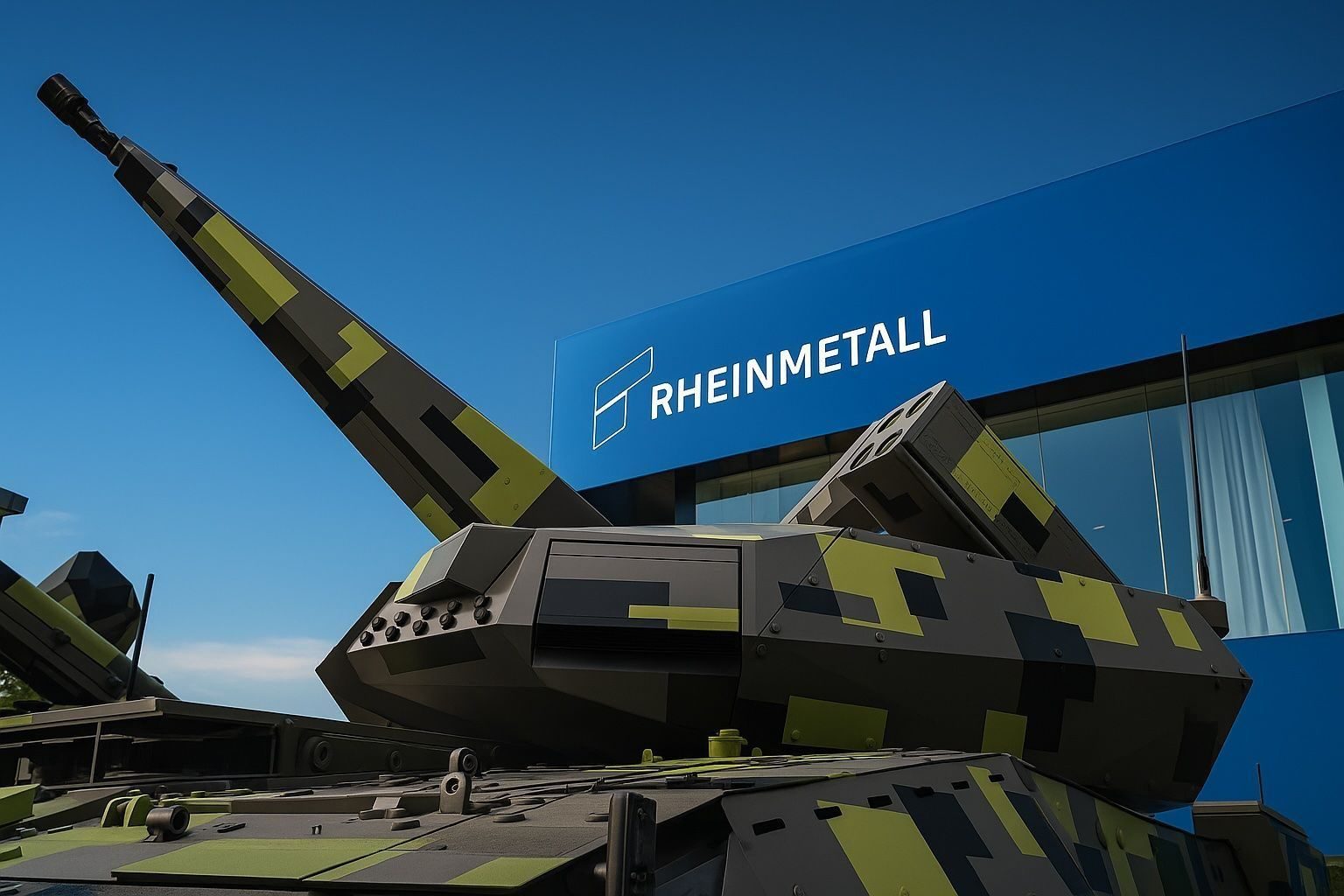Rheinmetall AG’s Frankfurt‑listed shares (ticker RHM.DE) ended Tuesday’s session on Xetra at €1,468, up 1.73% from Monday’s close of €1,443. European defence stocks broadly bounced after two punishing sessions, with the Stoxx 600 Aerospace & Defense index up about 1% and Germany’s DAX 40 gaining 0.97%. [1]
The move comes after a sharp sell‑off driven by headlines about a potential Ukraine peace framework, which had knocked Rheinmetall more than 14% lower over the past several days, according to multiple market and media reports. [2]
At the same time, 25 November has brought a fresh wave of company‑specific news:
- A mixed‑reality training partnership with Varjo, highlighted in several defence industry outlets today. [3]
- New coverage of Rheinmetall’s 2030 growth targets, including plans to lift sales to €50 billion with a strong push into naval systems. [4]
- Detailed reporting on how the group plans to meet massive demand for Boxer and Lynx armoured vehiclesdespite current capacity limits. [5]
- Clarification from Romania that there is no signed Lynx infantry fighting vehicle contract yet, despite earlier statements attributed to Rheinmetall’s CEO. [6]
Below is a structured look at Rheinmetall stock today – price action, fresh news from 25 November 2025, and how it fits into the longer‑term story investors are watching.
Rheinmetall Share Price on 25 November 2025
Closing snapshot (Xetra, Tuesday): [7]
- Last price: €1,468
- Daily change: +€25 (+1.73%)
- Intraday range: €1,436.50 (low) to €1,486.00 (high), a swing of about 3.45%
- Volume: ~374,000 shares, turnover roughly €549 million
- 52‑week range: €593 (low) to €2,008 (high)
- Market cap: ~€65.7 billion
Despite today’s bounce, technical data show: [8]
- The share price is down about 15% over the last 10 trading days.
- It trades roughly 27% below its 52‑week high around €2,008.
- Over 12 months, the stock is still up well over 100%, reflecting the extraordinary re‑rating of European defence since Russia’s full‑scale invasion of Ukraine.
German retail platforms such as wallstreet‑online described today’s move as a steep intraday recovery after Monday’s slump, noting that short‑term traders are trying to time the swings while long‑term investors focus on the underlying order book and defence cycle. [9]
What Moved Rheinmetall Today: Relief Rally After Peace‑Talk Panic
1. Sector bounce after Ukraine peace headlines
Over the past few days, markets reacted to reports that the US and Ukraine were working on a new peace framework, and that Kyiv was broadly receptive. Defence stocks sold off heavily across Europe as traders tried to price a shorter‑than‑expected war and a possible end to the “defence super‑cycle”. [10]
- On Monday, Rheinmetall fell around 4%, while other European defence names such as Leonardo, Saab and Thales also dropped. [11]
- Commentators described “panic” among arms‑industry investors as they considered what a peace deal might mean for order pipelines. [12]
Today, that trade partially reversed:
- The Stoxx 600 Aerospace & Defense index closed about 1% higher.
- Rheinmetall’s shares rose 1.73%.
- The broader Stoxx 600 and DAX 40 also finished in the green as markets refocused on expected Fed rate cuts and the reality that even a ceasefire would still require years of rearmament and replenishment. [13]
In other words, today’s move is best seen as a relief rally, not a new all‑time‑high surge. The stock is bouncing from a sharp drawdown but remains far below its early‑November peak.
2. New 2030 growth coverage: “€50 billion sales” and marine push
A fresh article syndicated today from tech‑and‑business outlet IT Boltwise and republished by Veritas News recaps Rheinmetall’s recently announced 2030 targets: [14]
- Sales ambition: Up to €50 billion by 2030 – more than double the group’s earlier medium‑term plan and roughly five times 2024 revenue.
- Margin target: Operating margin above 20% by 2030, raised from a previous 18% goal for 2027.
- Naval expansion: The plan relies heavily on integrating a new marine division, centred on the planned acquisition of the naval business of the Lürssen Group (NVL).
- Drivers:
- A sustained increase in NATO and EU defence budgets.
- Rheinmetall’s deepening role as a preferred supplier for Germany and other allies.
These ambitions were originally outlined at Rheinmetall’s Capital Markets Day earlier in November and are now being digested by the broader press and investor community. Reuters has highlighted that management expects the company’s order backlog to climb from around €64 billion at the end of Q3 to close to €80 billion by year‑end, underlining the visibility behind those long‑term goals. [15]
Fresh 25 November Headlines: Varjo Deal, Capacity Crunch and Romania
1. Rheinmetall–Varjo mixed‑reality training partnership
One of today’s most concrete corporate developments is the formal announcement – now echoed across several defence outlets – of a strategic partnership between Rheinmetall and Finnish XR specialist Varjo. [16]
Key points:
- Rheinmetall will integrate Varjo XR‑4 Series mixed‑reality headsets into its modular driving and weapon simulation systems.
- The goal is to scale land‑forces training capacity across Europe and NATO by allowing troops to train more flexibly, both at central bases and in forward locations.
- Mixed reality will let crews use real vehicle hardware while operating in high‑fidelity virtual terrains, improving realism without needing large fixed‑site simulators.
Rheinmetall and Varjo plan to demonstrate the joint solution at I/ITSEC 2025 in Orlando (1–4 December), showcasing an advanced XR truck‑driving simulator. Defence industry site European Security & Defence framed the partnership as a response to the urgent need to train larger forces quickly as NATO accelerates its readiness plans. [17]
For investors, the deal is unlikely to move near‑term earnings by itself, but it underscores Rheinmetall’s push into digital defence and training systems, one of the faster‑growing, higher‑margin pieces of its portfolio.
2. How Rheinmetall plans to build thousands of Boxer and Lynx vehicles
Another detailed report published today by Defense Express digs into Rheinmetall’s production plans for armoured vehicles: [18]
- Germany alone is expected to order 3,000–6,000 Boxer armoured fighting vehicles, while the potential global demand for Lynx infantry fighting vehicles could reach around 6,000 units, including a large US opportunity if Rheinmetall wins a Pentagon tender.
- Current estimated capacity for Boxer, Lynx and Puma vehicles is about 600 units per year, with actual output closer to 400 – far below the projected demand from 2030 onward.
- Rheinmetall’s plan includes:
- Establishing new localised production sites (for example through the Leonardo Rheinmetall Military Vehicles joint venture in Italy).
- Re‑tooling its Kassel plant in Germany to specialise in Boxer production, targeting roughly 500 units per year from that site alone once long‑term contracts are secure.
This capacity build‑out dovetails with Rheinmetall’s own statement that it aims to deliver tens of thousands of military vehicles across Europe over the coming years, a key pillar in achieving its 2030 revenue goal. [19]
3. Romania pushes back on reported Lynx contract
A separate article today from Defence Blog highlights a potential short‑term communications risk for Rheinmetall: [20]
- Romania’s government has explicitly denied that it has signed a contract to buy Lynx IFVs from Rheinmetall, despite earlier media reports quoting Rheinmetall CEO Armin Papperger suggesting such a deal existed.
- Officials stressed that the 298‑vehicle infantry fighting vehicle programme remains open, with Lynx, ASCOD and Redback still under consideration.
- The estimated programme value is around €2.99 billion, and the final decision is expected soon, linked to EU funding mechanisms under the SAFE initiative.
For the stock, this doesn’t necessarily change the long‑term opportunity in Romania, but it does illustrate the political and procedural uncertainty around large defence programmes. Markets may treat some of the more speculative order expectations with more caution until contracts are formally announced.
4. Space and satellites: ICEYE joint venture update
Rheinmetall also updated a corporate story today about its joint venture with Finnish SAR‑satellite operator ICEYE, which sits inside the group’s upcoming Digital Division. [21]
- The JV, Rheinmetall ICEYE Space Solutions GmbH, plans to start building radar satellites in Neuss(Germany) by mid‑2026.
- The aim is to give Germany and Europe more sovereign access to space‑based reconnaissance, including high‑resolution imagery in all weather conditions and at night.
- Ukraine already benefits from this cooperation via secure access to ICEYE satellite imagery, underscoring the operational relevance of the partnership.
While this satellite venture is still in its investment phase, it reinforces Rheinmetall’s push beyond “classic” land systems into space, digital intelligence and data services – all areas that could command premium valuations if scaled successfully.
Fundamentals Behind the Stock: Q3 2025 and Order Backlog
Rheinmetall’s share price volatility this month sits on top of very strong reported fundamentals.
In early November, the company reported Q3 2025 results showing: [22]
- First nine months sales: ~€7.5 billion, up 20% year‑on‑year.
- Operating result: €835 million, up 18%.
- Defence operating result: €825 million with a margin of about 13.6%.
- Order backlog: around €64 billion, driven by ammunition, vehicles and air‑defence programmes across Europe and NATO.
Management kept its 2025 guidance, still expecting: [23]
- 25–30% growth in full‑year sales (vs. roughly €9.8 billion in 2024).
- An operating margin of about 15.5%, slightly higher than last year.
The main weak spot is free cash flow: heavy capex for new factories, inventory build‑up and delayed German budget decisions pushed operating free cash flow deeply negative in the first nine months. Rheinmetall’s CEO told Reuters he expects a “flood of orders” to come through in late 2025 and early 2026 as procurement bottlenecks clear, helping cash generation to catch up with earnings. [24]
Valuation, Growth Forecasts and Analyst Sentiment
Valuation and upside implied by analyst targets
Data from several platforms today show that, even after the recent drop, Rheinmetall is still priced for strong growth:
- Consensus recommendation: Overall “Buy”, with around 18–24 analysts covering the stock depending on the dataset. Most rate it Buy, a minority Hold, and essentially none Sell. [25]
- Average 12‑month price targets:
- 52‑week range: €593–€2,008 – today’s price sits in the upper half of that band but significantly below the peak. [28]
Importantly, some qualitative research (including pieces from AInvest and others) stresses that while analysts see meaningful upside, valuation is far from cheap. Rheinmetall trades at rich earnings and sales multiples compared with the broader European market and many industrial peers, reflecting expectations of sustained double‑digit growth. [29]
Growth forecasts
Simply Wall St’s consolidated analyst model, updated yesterday, expects: [30]
- Earnings growth: ~35% per year over the next few years.
- Revenue growth: ~27% per year, outpacing both the German market and the wider aerospace & defence sector.
- Return on equity: forecast to reach around 31% within three years.
StocksGuide, compiling sell‑side estimates, maps out a revenue path from roughly €9.8 billion in 2024 to about €43 billion by 2030, still slightly below Rheinmetall’s own €50‑billion ambition but pointing in the same direction. [31]
Dividend profile
Rheinmetall remains primarily a growth story, not an income play:
- The last dividend was €8.10 per share, paid in May 2025.
- At today’s price, that implies a forward yield of roughly 0.5–0.6%.
- However, the dividend has grown at an average rate of about 30% per year over the past three years, according to dividend trackers. [32]
Key Risks Investors Are Weighing After Today’s Rebound
Even supporters of the stock acknowledge that Rheinmetall is high‑risk and highly cyclical despite its strong fundamentals. Commonly cited risks include: Defence Blog – Military and Defense News+3TechStock²+3Reuters+3
- Peace‑process and political risk
- A durable ceasefire or peace agreement in Ukraine could slow the pace of new orders, especially if governments use it as an excuse to ease budget pressure.
- Commentary from Reuters and others notes that part of Rheinmetall’s exceptional backlog is directly tied to the post‑2022 rearmament surge.
- Budget timing and bureaucracy
- Delays in German and EU budgets have already pushed some contracts to the right, hurting near‑term cash flow.
- Major programmes like the Romanian IFV tender show how political processes can diverge from company statements and expectations.
- Execution and capacity risk
- Building or expanding more than a dozen plants, re‑tooling sites like Kassel and localising production in multiple countries is complex.
- Today’s Defense Express report underscores that current production capacity is well below the volumes implied by potential Boxer and Lynx orders – ramp‑up missteps could affect margins and delivery schedules.
- Valuation and volatility
- After years of outsized gains, Rheinmetall’s share price is extremely sensitive to macro headlines, peace rumours and shifts in investor sentiment.
- Technical services like StockInvest actually flag the stock as being in a falling short‑term trend despite today’s bounce, reflecting elevated downside risk if sentiment turns again. [33]
What to Watch After 25 November 2025
Looking beyond today’s 1.7% rebound, here are the main catalysts and questions markets are likely to watch:
- Follow‑through from the 2030 strategy
- Concrete steps on the NVL naval acquisition and integration of the marine division.
- Updates on plant expansions, especially in Germany, Italy and Lithuania, and whether capacity targets are met on time. [34]
- Large contract announcements
- Cash‑flow trajectory
- How operating cash flow develops in Q4 2025 and into 2026 as delayed orders are booked and the first wave of new capacity starts contributing.
- Macro backdrop and Ukraine peace efforts
- Any concrete peace deal would have complex effects: near‑term order risk on one side, long‑term demand for replenishment and deterrence on the other.
- Investors will watch whether politicians treat rearmament as a structural necessity or a temporary response to the war. [37]
Final word
On 25 November 2025, Rheinmetall stock is caught between two powerful narratives:
- A structurally strong business with a record backlog, aggressive 2030 growth plan, and expanding footprint in naval systems, digital defence, training and space.
- A volatile market narrative in which every new headline about Ukraine peace, defence budgets or valuation triggers sharp swings in a highly crowded trade.
Today’s 1.73% gain to €1,468 is a modest step back from the brink after a punishing sell‑off – not the start of a fresh vertical rally, at least not yet. For readers following RHM.DE, the decisive factors will be whether Rheinmetall can convert its backlog into profitable, cash‑generating growth and how durable the political consensus for elevated defence spending proves to be.
Important: This article is for journalistic and informational purposes only and does not constitute investment advice, an offer, or a recommendation to buy or sell any security. Anyone considering an investment in Rheinmetall or other defence stocks should carefully assess their own financial situation, risk tolerance and ethical considerations, and, where appropriate, consult a licensed financial adviser.
References
1. stockinvest.us, 2. stockinvest.us, 3. euro-sd.com, 4. ckh.enc.edu, 5. en.defence-ua.com, 6. defence-blog.com, 7. stockinvest.us, 8. stockinvest.us, 9. www.wallstreet-online.de, 10. www.reuters.com, 11. www.reuters.com, 12. borna.news, 13. www.aa.com.tr, 14. ckh.enc.edu, 15. www.reuters.com, 16. euro-sd.com, 17. euro-sd.com, 18. en.defence-ua.com, 19. www.reuters.com, 20. defence-blog.com, 21. www.rheinmetall.com, 22. www.reuters.com, 23. www.rheinmetall.com, 24. www.reuters.com, 25. www.investing.com, 26. www.investing.com, 27. stocksguide.com, 28. www.investing.com, 29. www.ainvest.com, 30. simplywall.st, 31. stocksguide.com, 32. www.digrin.com, 33. stockinvest.us, 34. www.reuters.com, 35. www.reuters.com, 36. defence-blog.com, 37. www.aa.com.tr







